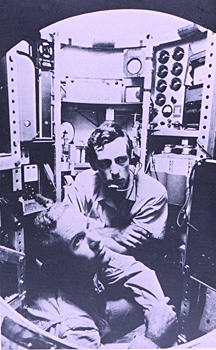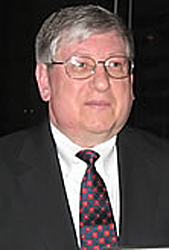According to tradition, a previous signer of the globe must introduce and “pass the pen” to Capt. Brigham. Fittingly, that past signer, Don Walsh, also has saltwater in his veins. Walsh, the first submersible pilot in the United States, entered the world's record books on Jan. 23, 1960, when he and Swiss scientist Jacques Piccard dived in the Navy bathyscaph Trieste to the deepest point in the ocean--nearly seven miles underwater. The location was 35,840 feet beneath the surface of the Pacific in the Mariana Trench.
A press release issued Feb. 1, 1960, by the U.S. Department of the Navy, and quoting Admiral Arleigh Burke, chief of naval operations, termed the record-breaking feat an accomplishment that "may well mark the opening of a new age in exploration of the depths of the ocean which can well be as important as exploration in space has been in the past."
Also welcoming Brigham to the podium will be John Noble Wilford, who has served as science correspondent, assistant national news editor, and director of science news at The New York Times. Wilford is the winner of two Pulitzer prizes--for national reporting of science topics in 1984, and as part of a team effort reporting on the Challenger explosion and its aftermath in 1987. He has been the author, coauthor or editor of eight books and has received numerous awards, including the Westinghouse Science Writing Award and two honorary doctorates.
Wilford will serve as a symbolic link to John H. Finley, the former editor-in-chief of The New York Times, who started the globe-signing tradition. In his position at the newspaper, Finley invited early heroes of exploration and aviation to draw their routes and sign their names on his 18-inch globe. In 1929, Finley, who was then also the president of the American Geographical Society, gave the society the globe as a gift. As noted on its Web site, the society has continued the globe-signing custom ever since, and in so doing, “has created a remarkable and unique symbol of humanity's unquenchable drive to explore the universe.”
The globe's signers include more than 75 intrepid men and women who have explored the farthest reaches of the Earth, pioneered new means of travel, or set aviation records. Among them are Charles Lindbergh and Amelia Earhart, John Glenn, Neil Armstrong, Roald Amundsen, Robert Peary, William Beebe and Sir Edmund Hillary, to name but a few.As a captain in the U.S. Coast Guard, Lawson Brigham commanded the icebreaker Polar Sea on the first voyage to the polar extremes of the global ocean, from the Ross Ice Shelf in Antarctica to the North Pole. Today, Brigham is deputy director of the U.S. Arctic Research Commission in Anchorage and chairs the Arctic Marine Shipping Assessment of the Arctic Research Council, an intergovernmental forum of the eight Arctic nations.
A collection of antique polar maps on loan from Capt. Brigham, photography by participants in UD's recent study-abroad program in Antarctica, and polar projects by Delaware schoolchildren will be featured in the Roselle Center's reception hall after the signing ceremony.
Julia Dooley, a teacher at Jennie Smith and West Park Place elementary schools in the Christina School District, is coordinating the student displays. Dooley was one of five schoolteachers from across the United States selected to participate in the National Science Foundation's U.S. Antarctic Program. She recently spent two months in Antarctica learning firsthand about the extreme environment and polar research and is now sharing her knowledge with Delaware students. A selection of photographs from Dooley's Antarctic experiences also will be on display.
After the signing event, the globe, Brigham's collection of polar maps, and other artifacts from the polar regions will remain on display on the second floor of UD's Morris Library from Feb. 13 through March 14. Polar research from across the University also will be on exhibit at the reception and in the library.
At 7:30 p.m., Thursday, Feb. 14, at UD's Roselle Center for the Arts, the free public lecture “A New Arctic Ocean: Responding to Marine Access Change at the Top of the World” will be presented by Lawson Brigham. He will highlight what the receding sea ice means to trade, tourism and resource use in the once-remote Arctic.

Both events are free; however, seating is limited, and registration is required. Register online at [www.udel.edu/research/polar/events.html]. For more information, contact the UD Office of Public Relations at (302) 831-2791.
Article by Tracey Bryant



